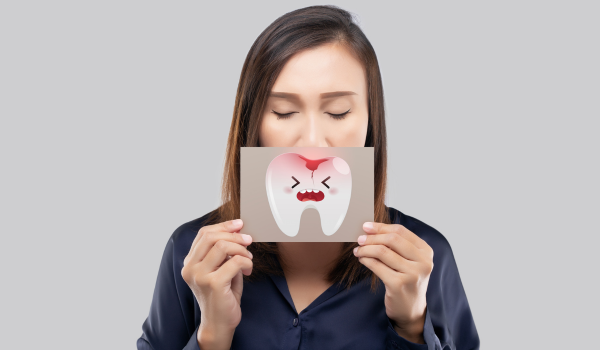.png)
Gingivitis is the most common type of gum disease and, if left untreated, can lead to more severe dental problems. It is often reversible if caught in the early stages. Recognizing the signs and symptoms of gingivitis is crucial for early intervention and effective treatment. In this article, we will explore the most common symptoms of gingivitis, including swollen gums, bleeding when brushing, bad breath, and more. Understanding these signs will help you take the necessary steps to protect your oral health.
1. Swollen and Red Gums: The First Visible Sign
One of the first noticeable symptoms of gingivitis is swollen and inflamed gums. This happens when plaque buildup at the gumline causes irritation and inflammation of the gum tissue. Here’s what to look for:
-
Redness: Healthy gums are typically a pale pink color. When the gums become inflamed due to gingivitis, they may appear redder than usual, especially along the gumline.
-
Swelling: Swollen gums may appear puffy or enlarged, and they may feel tender to the touch. This swelling is a result of increased blood flow to the affected area as the body tries to combat the irritation caused by plaque.
-
Softness: Inflamed gums become soft and may feel spongy, which makes them more prone to injury.
If you notice swollen or red gums, it’s essential to take immediate action to improve your oral hygiene and prevent the condition from worsening.
2. Bleeding Gums When Brushing or Flossing
Bleeding gums, particularly when brushing or flossing, is another common early symptom of gingivitis. This occurs because plaque buildup around the gumline causes the gum tissue to become tender and more susceptible to bleeding. Here’s what to keep in mind:
-
Bleeding During Brushing: If your gums bleed when brushing your teeth, it may indicate that they are inflamed and irritated. While it’s normal for gums to bleed a little after aggressive brushing, frequent bleeding is a warning sign of gingivitis.
-
Bleeding During Flossing: Gums that bleed when you floss, especially if this happens consistently, are also a sign of gingivitis. Flossing helps remove plaque and food particles, but if the gums are swollen and inflamed, they may bleed more easily.
If you notice bleeding gums, it’s important to see a dentist for an evaluation. Persistent bleeding can lead to more severe gum disease if left untreated.
3. Bad Breath (Halitosis): A Sign of Infection
Bad breath, also known as halitosis, is another common symptom of gingivitis. It occurs when the bacteria in plaque and tartar produce sulfur compounds, which cause an unpleasant odor. Here’s how to recognize bad breath associated with gingivitis:
-
Persistent Bad Breath: While occasional bad breath is normal, chronic bad breath that lingers despite regular brushing may indicate gingivitis. This is because the bacteria in your mouth break down food particles, leading to foul-smelling compounds.
-
Foul Taste in the Mouth: In addition to bad breath, you may experience a metallic or unpleasant taste in your mouth. This taste is also caused by the bacteria associated with gingivitis.
If bad breath or an unpleasant taste persists, it’s important to seek professional dental care to address the underlying cause.
4. Receding Gums: When the Gums Pull Away from the Teeth
Receding gums occur when the gum tissue begins to pull away from the teeth, exposing more of the tooth’s surface or the tooth root. Receding gums are a more advanced symptom of gingivitis but can also be seen in its early stages. Here’s what to watch for:
-
Visible Tooth Roots: As the gums recede, the roots of the teeth may become visible, making the teeth appear longer. This is a sign that the gum tissue is shrinking due to inflammation and plaque buildup.
-
Increased Sensitivity: When the gumline recedes, it can expose the tooth roots, making them more sensitive to hot, cold, or acidic foods and drinks.
Receding gums are a sign that the inflammation from gingivitis is progressing, and prompt treatment is needed to prevent further damage to the gums and teeth.
5. Tenderness and Pain in the Gums
Gingivitis can cause discomfort in the gums, especially when touched or when performing regular oral care activities. Gums that are tender or painful to the touch are often a sign of inflammation and irritation. Common symptoms include:
-
Pain While Brushing or Flossing: Inflamed gums may hurt when brushing or flossing, which is an indication that the tissues are irritated. This pain can range from mild discomfort to more significant pain if the gums are severely inflamed.
-
Soreness in the Mouth: In addition to bleeding and swelling, the gums may feel sore, especially after eating, drinking, or engaging in physical activity that involves the mouth.
Gum tenderness is a sign that your gums are not healthy and require attention to prevent the condition from worsening.
6. Pockets Between Teeth and Gums
As gingivitis progresses, it can lead to the formation of small pockets between the gums and teeth. These pockets occur when the gum tissue starts to pull away from the teeth due to infection and inflammation. Here’s how to recognize this symptom:
-
Increased Pocket Depth: Healthy gums sit tightly around your teeth. If gingivitis develops into periodontitis, the gum pockets deepen, allowing bacteria to thrive and causing further damage to the gum tissue.
-
Food Debris in Pockets: You may notice food particles getting trapped in these pockets, which can contribute to a cycle of bacterial growth and worsen the condition.
Detecting gum pockets early is important, as they can be an indicator that gingivitis has progressed into a more severe form of gum disease.
7. Gum Abscesses and Pus Formation
Although less common, an abscess or the formation of pus in the gums can occur if gingivitis is not treated. This is a sign that the infection has spread deeper into the gum tissue. Here’s what to look for:
-
Pus Around the Gums: If you notice pus or a yellowish fluid oozing from the gums, it indicates an infection that may require antibiotics or other treatments to resolve.
-
Painful Bumps or Swelling: Gum abscesses can cause painful, swollen areas in the gums that are tender to the touch. These abscesses are a more severe symptom of gingivitis and require immediate dental care.
Abscesses in the gums are a sign of advanced gum disease and need to be treated by a dentist or periodontist as soon as possible to prevent further complications.
.png)
.png)
.png)
.png)
.png)
.png)
.png)
.png)
.png)



